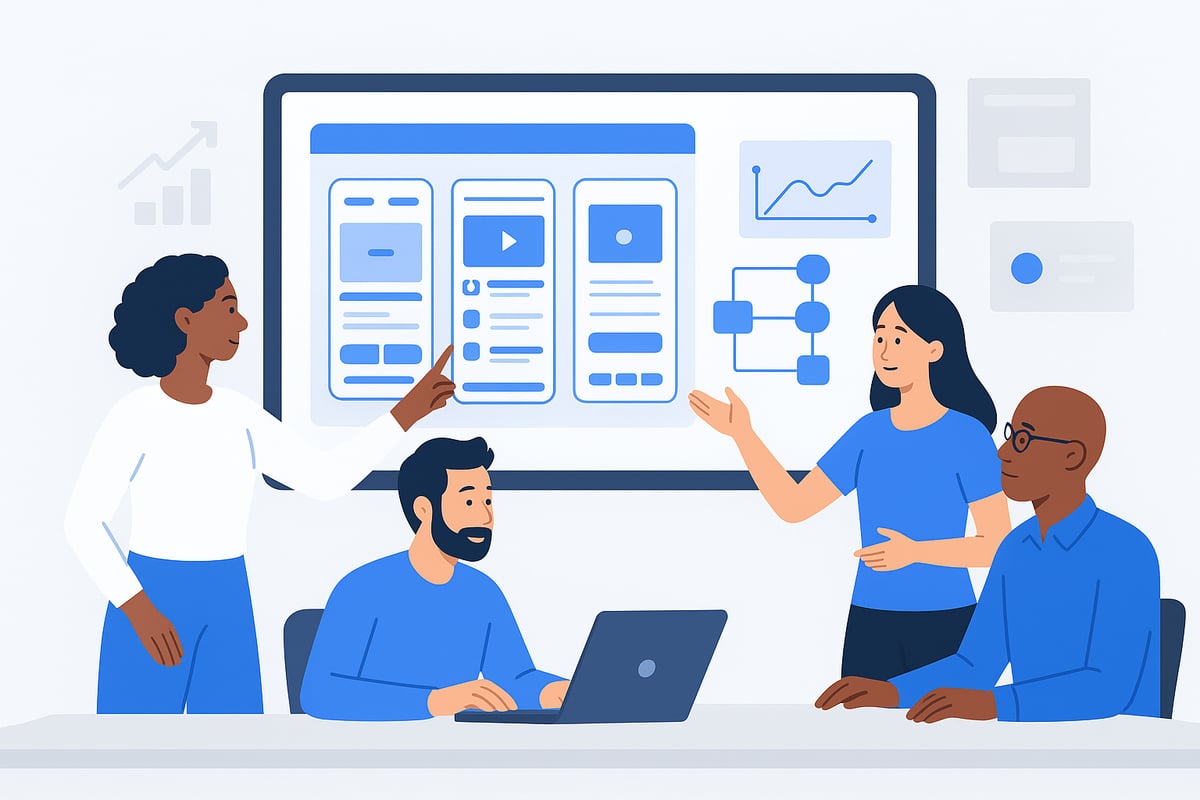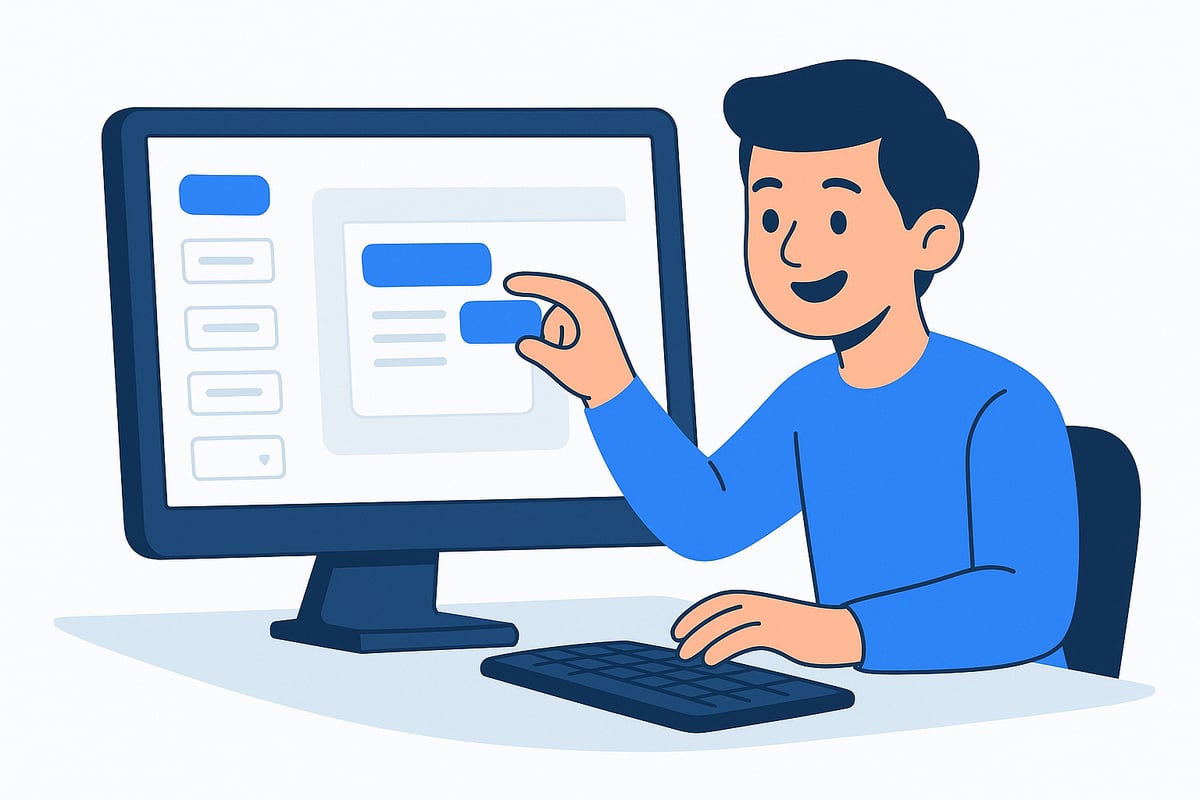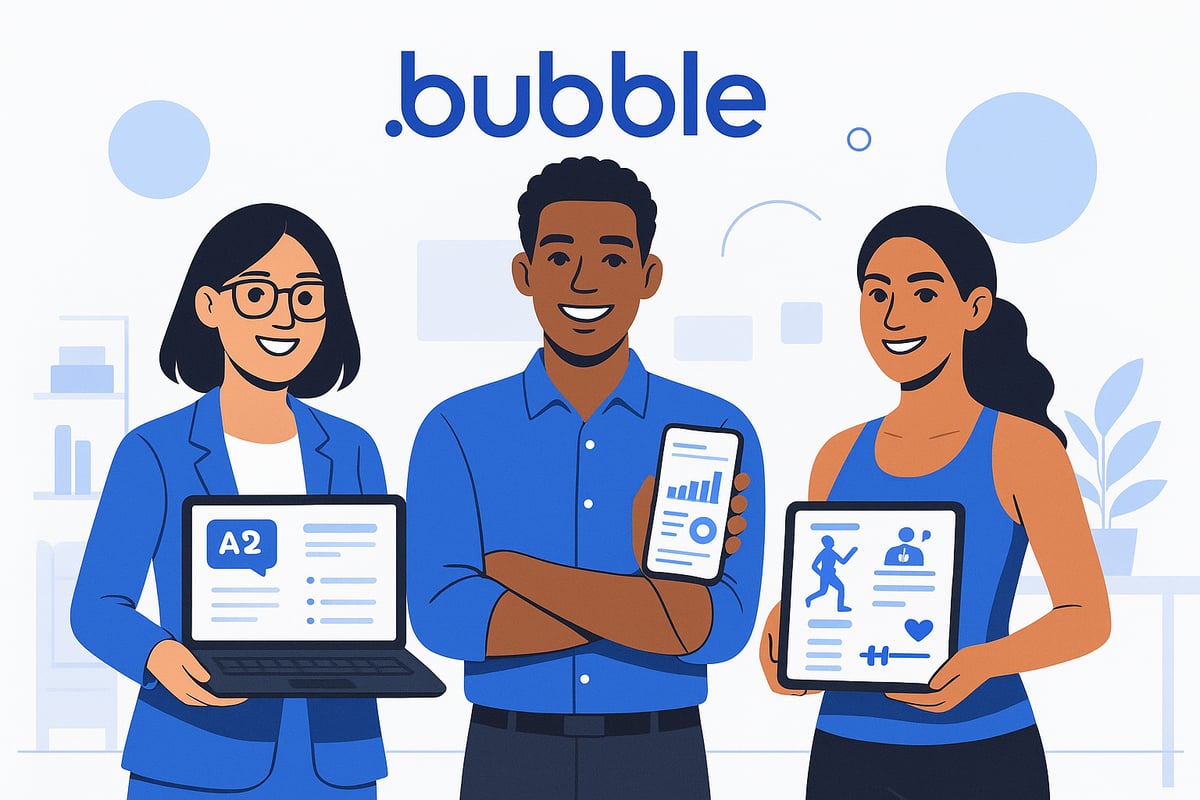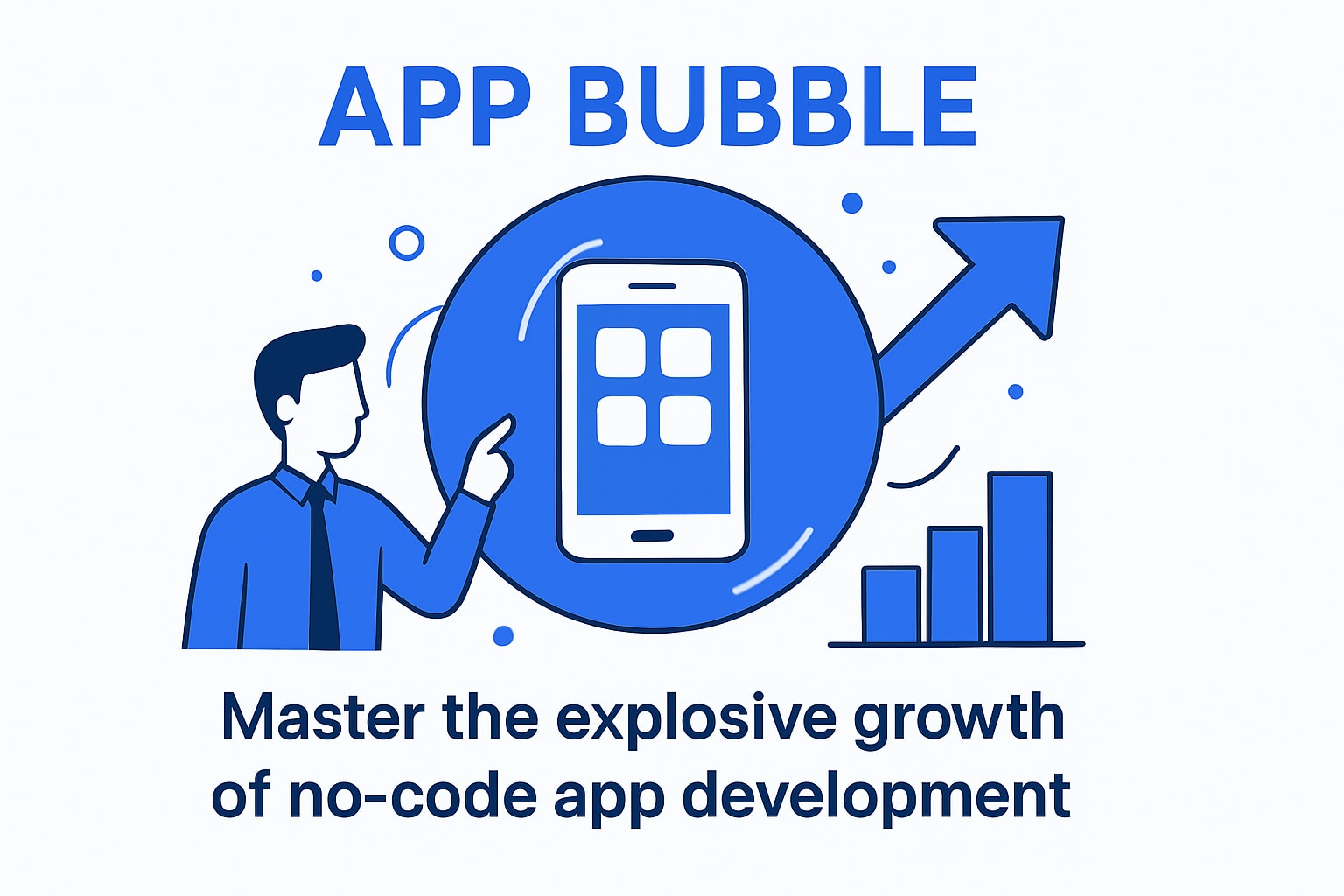No-code development is exploding, and 2025 is shaping up to be the year anyone can build powerful apps without writing a single line of code. With platforms like app bubble, you can now turn your ideas into fully functional apps faster than ever.
This guide will help you master app bubble, the leading no-code platform, so you can launch your own app in days, not months. We’ll walk you through what Bubble is, why no-code is on the rise, how to build your app step by step, unlock advanced features, monetize your project, and explore future trends.
Ready to become a no-code app master in 2025? Let’s dive in.
The Rise of No-Code and Bubble in 2025
The world of app development is transforming at lightning speed, and the app bubble is at the center of this revolution. In 2025, no-code platforms are rewriting the rules, empowering people from all backgrounds to build powerful digital solutions without traditional programming. Let's explore how this movement is breaking barriers, why Bubble leads the pack, and why now is the perfect time to dive in.

The No-Code Movement: Breaking Barriers
No-code platforms have evolved from simple website builders to robust environments for creating full-featured apps. These tools let users visually assemble applications using drag-and-drop interfaces and logic editors, making software creation accessible to anyone.
2025 is a pivotal year for no-code, with adoption rates soaring across industries. The market is set to hit $65 billion by 2027, according to No-Code Development Market Growth Projections. This surge is driven by the democratization of technology—now, entrepreneurs, marketers, and teachers can all join the app bubble, turning ideas into reality without hiring developers.
Real-world results are everywhere. Startups are launching MVPs in weeks instead of months. Large enterprises use no-code for rapid prototyping and internal tools. The app bubble means more people are solving real problems, faster and at a lower cost.
Bubble: The Powerhouse of No-Code Development
Bubble stands out as a leading platform in the app bubble thanks to its unique combination of flexibility, scalability, and powerful features. With a drag-and-drop interface, robust visual workflows, and integrated database management, Bubble lets users design, build, and launch complex applications visually.
Bubble's growth is impressive, boasting over 2 million users and more than 1,500 apps built on its platform. What sets Bubble apart from competitors is its flexibility in handling custom functionality, its wide plugin ecosystem, and the ability to scale apps from solo projects to enterprise-level solutions.
Take a look at real-world examples: Tutor Lily delivers AI-powered language tutoring, Evo Signals provides real-time finance insights, and Fitside offers personalized AI fitness coaching. All were launched using the app bubble approach, proving that Bubble's toolset can support diverse industries and ambitious ideas.
| Feature | Bubble | Competitors |
|---|---|---|
| Visual Editor | Yes | Yes |
| Plugin Ecosystem | Extensive | Limited |
| Scalability | High | Varies |
| User Base | 2M+ | <1M |
Why Learn Bubble Now?
The demand for rapid app prototyping and deployment is at an all-time high. As businesses race to innovate, the app bubble provides a cost-effective and scalable solution that bridges the tech talent gap. With Bubble, you can launch apps in days, not months, and adapt quickly to market changes.
Learning Bubble now means you are future-proofing your skills for the digital economy. Companies seek creators who can build, test, and iterate without waiting for scarce developer resources. The app bubble is not just a trend—it's a lasting shift in how technology is built and delivered.
Whether you're an entrepreneur, freelancer, or part of a growing business, mastering Bubble gives you the power to turn ideas into working products and seize new opportunities in 2025.
Getting Started: Setting Up Your First No-Code App with Bubble
Ready to launch your app bubble journey? This section walks you through every essential step, from brainstorming your idea to previewing your no-code app. With each stage, you’ll unlock practical tips to make your first app bubble project a success.

Step 1: Planning Your App Idea
Every great app bubble project starts with a clear vision. Think about a problem you face or a need within your community. What solution would make life easier or more enjoyable?
Next, define your app bubble’s core purpose. Is it for social networking, productivity, or maybe personal finance? Research what similar solutions exist, and pinpoint what sets your idea apart.
Sketch out your must-have features and how users will move through the app bubble. A simple flowchart or bullet list helps clarify how users interact with your app. This upfront planning keeps your project focused and user-friendly.
Step 2: Creating a Bubble Account and Project
To bring your app bubble idea to life, start by signing up for a Bubble account. Bubble offers both free and paid plans, so you can experiment without any upfront investment.
Once registered, you’ll land on the dashboard. Here, you can create a new project, name it, and decide whether to use a ready-made template or build from scratch. Templates offer a quick start, while starting blank gives you total control.
For a step-by-step breakdown of setting up your first app bubble, check out Building apps with Bubble. It covers everything from registration to project creation, perfect for beginners.
Step 3: Designing Your App Visually
Designing your app bubble is easy with Bubble’s drag-and-drop editor. You’ll see a visual canvas where you can add elements like buttons, text, forms, and images. Just drag items onto the page and arrange them to match your vision.
Customize each element to fit your brand. Adjust colors, fonts, and images for a unique look. Don’t forget about responsiveness—use Bubble’s settings to make sure your app bubble looks great on both desktop and mobile devices.
Test your layout as you go, tweaking placements for the best user experience. The visual approach makes design accessible, even if you’re new to tech.
Step 4: Building Workflows and App Logic
Now, it’s time to add intelligence to your app bubble. Bubble’s visual workflow builder lets you automate what happens when users interact with your app.
For example, set up a workflow that triggers when someone signs up or submits a form. You can add actions like sending notifications, storing data, or displaying custom messages. Think of workflows as connecting the dots between user actions and outcomes.
Want to connect with outside services? Bubble supports API integrations, so your app bubble can pull in data or send info elsewhere. Even without code, you can create powerful app logic.
Step 5: Testing and Previewing Your App
Before sharing your app bubble with the world, test everything thoroughly. Use Bubble’s preview mode to see how your app works in real time. Try signing up, submitting forms, and navigating different pages.
If something doesn’t work as expected, use the built-in debugging tools to spot and fix issues. Invite a few friends or early users to try your app bubble and share feedback.
Iterate based on what you learn. Early testing helps you catch problems and refine the user experience, setting your app bubble up for a smooth launch.
Unlocking Advanced Features and Native App Capabilities
Ready to take your app bubble project beyond the basics? Unlocking advanced features and native app capabilities is what transforms a simple no-code app into a powerful, scalable product. Let’s explore how you can level up your app bubble experience in 2025.

Integrating Native Mobile Features with Plugins
One of the most exciting aspects of app bubble development is integrating native mobile features—no coding required. Bubble’s plugin ecosystem lets you add functionalities like push notifications, camera access, and geolocation directly into your app bubble project.
Plugins like Natively make it possible to convert your web app into native iOS and Android versions in minutes. This means you can access device hardware, send targeted push notifications, and provide seamless user experiences. Security is top-notch, as publishing does not require sharing developer accounts.
Want to explore even more advanced plugin options? Check out the Top AI plugins for Bubble apps to see how machine learning and automation can elevate your app bubble even further.
Monetization and In-App Purchases
Monetizing your app bubble is easier than ever in 2025. With integrations like RevenueCat, you can offer in-app purchases, subscriptions, and one-time payments without complex code. This opens up revenue streams for both hobbyists and entrepreneurs.
Set up different payment models based on your audience’s needs. For example, you might offer a freemium model with premium upgrades or a recurring subscription for exclusive content. Real-world app bubble creators have successfully implemented these strategies to scale their businesses.
To streamline user payments, connect with trusted payment gateways and ensure your checkout process is smooth. This reduces friction and increases conversion rates for your app bubble.
Analytics, User Engagement, and Growth
Understanding your users is key to growing your app bubble. Integrate analytics tools like AppsFlyer or Facebook Analytics to track user behavior, retention, and acquisition.
Push notifications, enabled via plugins like OneSignal, help boost engagement and keep users coming back. Studies show that effective push campaigns can double retention rates and increase new user acquisition by over 80 percent for app bubble projects.
Use these insights to refine your features, personalize experiences, and plan marketing strategies. The right analytics setup makes it easy to spot what’s working and what needs improvement in your app bubble journey.
Social Auth and Seamless Onboarding
User onboarding should be quick and painless in any app bubble. Enable social login options like Google, Facebook, or Apple to simplify registration and build trust.
Social authentication not only speeds up sign-ups but also enhances security for your app bubble users. With just a few clicks, users can access your app bubble without lengthy forms.
Reducing friction at this stage means higher conversion rates and happier users. Plus, social logins are familiar and convenient, making your app bubble more appealing in a crowded market.
Publishing to App Stores
Launching your app bubble on the Apple App Store or Google Play is a major milestone. Bubble’s native packaging tools and plugins make this process straightforward, even for first-timers.
Before submission, thoroughly test your app bubble using preview and debug features to catch issues early. Prepare your app assets—icons, screenshots, descriptions—and review guidelines for each store.
Common pitfalls include missing permissions or unclear privacy policies, so double-check documentation. With careful preparation, your app bubble can reach users everywhere and make a real impact.
Real-World Success Stories: No-Code Apps Built with Bubble
The rise of the app bubble has empowered creators to launch functional, scalable apps without traditional coding skills. Let’s explore how real businesses are thriving with no-code innovation.

Tutor Lily: AI Language Tutor
Tutor Lily is a standout example of what’s possible with app bubble. The team rapidly prototyped their AI-powered language tutor, leveraging Bubble’s visual workflows and database tools.
This approach let them test ideas quickly and iterate based on user feedback. Within weeks, Tutor Lily launched to real users. The app bubble platform enabled seamless integration with AI APIs, making personalized language learning accessible to thousands.
Users praise the intuitive design and fast updates. By using app bubble, Tutor Lily avoided high development costs and scaled their solution to reach a global audience.
Evo Signals: Finance and Community
Evo Signals demonstrates how app bubble supports complex, data-driven apps. The founders built a finance platform with real-time trading signals and a vibrant user community.
With app bubble, they created secure user authentication, robust data handling, and interactive dashboards. The drag-and-drop interface meant rapid iteration, even as feature requests grew.
Evo Signals credits the app bubble ecosystem for enabling quick pivots and integrations. Their community features, built without code, helped boost engagement and learning among users.
Fitside: AI Fitness Trainer
Fitside combined AI and app bubble to deliver personalized fitness coaching across platforms. The app provides workout plans, tracks progress, and offers real-time feedback using AI integrations.
Monetization was streamlined through subscription management and in-app purchases, all set up with app bubble’s plugin marketplace. Fitside launched on web, iOS, and Android, reaching users wherever they are.
The founders highlight the speed and flexibility of app bubble, which let them refine the user experience and expand features based on feedback.
Lessons from 1,500+ Bubble Apps
Across industries, thousands of founders have harnessed app bubble to innovate rapidly. Here are some key takeaways:
- Education, health, finance, and lifestyle sectors benefit from app bubble’s flexibility.
- No-code tools accelerate MVP launches and lower barriers for entrepreneurs.
- Community support and robust documentation drive ongoing success.
If you’re inspired by these stories, check out No-code development with Bubble for insights on how app bubble can transform your own app journey.
App bubble is not just a trend, it’s a proven path to bringing ideas to life and scaling them for real-world impact.
Mastering Bubble: Tips, Resources, and Community Support
Mastering app bubble in 2025 means staying ahead of the curve and leveraging every resource available. Whether you are a beginner or looking to scale your expertise, the right tools and community support are essential. Let’s break down the best ways to enhance your journey with app bubble and set yourself up for success.
Essential Learning Resources for Bubble in 2025
To truly master app bubble, start by diving into official documentation and step-by-step tutorials. Bubble’s learning hub is packed with guides for every skill level, making it easy to build confidence from your first project onward.
Video tutorials and community-driven courses accelerate your learning curve. Platforms like YouTube and Udemy offer updated courses tailored for 2025’s features. For insights into recent trends and the impact of AI in no-code, explore the State of No-Code Development in 2024.
Don’t overlook the power of forums, blogs, and Discord communities. These spaces connect you with other app bubble builders who can offer tips, feedback, and support as you grow.
Troubleshooting and Getting Help
Even with the most intuitive platform, challenges can arise. For app bubble beginners, common hurdles include understanding workflow logic, database structuring, or integrating plugins.
Fortunately, Bubble’s support system is robust. The documentation provides step-by-step solutions for most issues. The active community on forums and Discord groups is quick to offer advice and practical fixes, ensuring you never feel stuck with your app bubble project.
Responsive customer service adds another layer of support. When you encounter roadblocks, reaching out through official channels often gets you detailed, actionable help, so your progress remains uninterrupted.
Staying Ahead: Updates, Plugins, and Best Practices
The app bubble landscape evolves rapidly, so staying updated is crucial. Regularly check for new features, plugin releases, and best practices shared by Bubble and the community.
Adopt habits like testing your builds frequently, optimizing for scalability, and prioritizing security. Networking with other app bubble creators helps you discover fresh ideas and avoid common pitfalls.
Engage in collaborative projects and participate in online events to expand your knowledge. Sharing your experiences not only benefits others but also sharpens your own skills within the app bubble ecosystem.
The Future of No-Code: Trends to Watch in 2025
Looking ahead, app bubble is set to benefit from major trends. AI integration and automation are becoming core features, making app development even more accessible and powerful.
Native mobile capabilities are expanding, allowing for seamless cross-platform deployment. Enterprises and startups alike are adopting app bubble to bridge tech gaps and drive innovation. For a deeper dive into what’s next, check out the No-Code Platform Buyer's Guide 2025.
Staying informed about these changes ensures your app bubble skills remain relevant and in demand as the no-code revolution continues.
Step-by-Step Guide: Building and Launching a Bubble App in 2025
Ready to turn your vision into a real product? This hands-on guide walks you through every phase of creating, refining, and launching your app bubble project in 2025. Whether you’re starting from scratch or optimizing an existing idea, each step is designed for clarity and action.
Step 1: Ideation and Scoping
Every successful app bubble journey starts with a clear idea. Begin by brainstorming solutions to real-world problems or gaps you’ve noticed in the market. Research trends, analyze competitors, and validate your concept with potential users.
Outline your app’s core features. What’s the minimum viable product you can launch? Map out user journeys with wireframes, focusing on simplicity and usability. Ask yourself: What will make users return to your app bubble over others?
List key features and prioritize them:
- Core functionality (must-haves)
- Nice-to-haves (can wait for future updates)
- Unique selling points
With a clear scope, you’ll be ready for a smooth build.
Step 2: Setting Up Your Bubble Environment
Sign up for a Bubble account — choose between free and paid plans based on your needs. Once inside, create a new project. The Bubble dashboard is intuitive, guiding you through project setup with templates or a blank canvas.
Import your brand assets, such as logos and color schemes, and define your app bubble’s look early. This ensures visual consistency. If you’re new to Bubble’s approach, you might want to explore the Bubble Programming Language Overview for a deeper understanding.
Organize your workspace, naming pages and elements clearly. This will make scaling your app bubble much easier down the line.
Step 3: Designing the User Interface
Design is where your app bubble begins to take shape. Use Bubble’s drag-and-drop editor to add forms, navigation menus, images, and other media. Arrange UI elements for logical flow and easy navigation.
Focus on responsive design. Test layouts on mobile, tablet, and desktop to ensure your app bubble looks great everywhere. Don’t forget accessibility: use high-contrast colors, clear fonts, and alt text for images.
Create a style guide to maintain a consistent look and feel. This helps users recognize your app bubble brand instantly.
Step 4: Building App Logic and Workflows
Now, bring your app bubble to life with workflows. Use Bubble’s visual builder to set up user actions like sign-up, login, form submissions, and notifications. Define database structures for storing user data and app content.
Add conditional logic to personalize user experiences. For example, display different content based on user roles or preferences. This step ensures your app bubble is both dynamic and scalable.
Test each workflow as you build. This reduces errors and helps you catch logic gaps early.
Step 5: Integrating Third-Party Services and Plugins
Supercharge your app bubble by adding plugins for payments, notifications, analytics, and more. The Bubble marketplace offers tools like Stripe for payments, OneSignal for push notifications, and analytics platforms for tracking user behavior.
For native app features, the Natively plugin streamlines adding push notifications, in-app purchases, and geolocation. This allows your app bubble to offer mobile-specific experiences without extra coding.
Reference competitor case studies to see how plugins can solve real-world challenges and unlock new capabilities for your app bubble.
Step 6: Testing, Debugging, and User Feedback
Before launch, test your app bubble thoroughly. Use Bubble’s preview and debug modes to check workflows, data flows, and UI responsiveness. Invite beta testers to use the app bubble and provide honest feedback.
Document bugs and prioritize fixes. Shorten feedback loops by iterating quickly. Early user insights can reveal usability issues or missing features, helping your app bubble stand out from competitors.
Testing is ongoing — keep refining based on real user data.
Step 7: Preparing for Launch and App Store Submission
With your app bubble polished, it’s time to prepare for launch. Package your app for web and, if needed, native deployment on iOS and Android. Follow app store guidelines closely to avoid rejection.
A crucial step is setting up a custom domain for your app bubble. For a detailed walkthrough, see this step-by-step custom domain setup. Double-check all assets, privacy policies, and permissions before submitting.
Be ready for the review process. Prepare a checklist:
- Test all features again
- Ensure compliance with app store rules
- Have marketing materials ready
Step 8: Post-Launch Growth and Optimization
Launch is just the beginning for your app bubble. Monitor analytics to track user engagement, retention, and growth. Use this data to roll out updates and new features that keep your audience engaged.
Implement marketing strategies like push notifications, referral programs, and social sharing to grow your user base. Keep gathering feedback and iterating — a thriving app bubble evolves with its users.
Celebrate milestones, learn from challenges, and stay active in the Bubble community for ongoing support and inspiration.
Now that you’ve seen how no code platforms like Bubble are opening doors for founders and teams in 2025, imagine what you could build if you started today. Whether you’ve got your first app idea or you’re ready to scale fast, you don’t need months of coding or a huge budget to bring your vision to life. With the right strategy and support, you can launch your MVP in a matter of weeks and start making an impact sooner. Ready to see what’s possible? Check out how you can Launch Your MVP in Weeks, Not Months.




About Big House
Big House is committed to 1) developing robust internal tools for enterprises, and 2) crafting minimum viable products (MVPs) that help startups and entrepreneurs bring their visions to life.
If you'd like to explore how we can build technology for you, get in touch. We'd be excited to discuss what you have in mind.
Other Articles
Discover the best artificial intelligence app picks for 2025 Explore top AI apps transforming productivity creativity and business with key features and expert tips
Discover 7 smart ways to hire mobile app developer in 2025 with proven strategies for sourcing vetting and future proof contracts to ensure project success
Discover essential software development trends for 2025: AI/ML integration, low-code platforms, cloud-native architecture, and green coding. Complete guide with strategic planning, team management, and security best practices.

